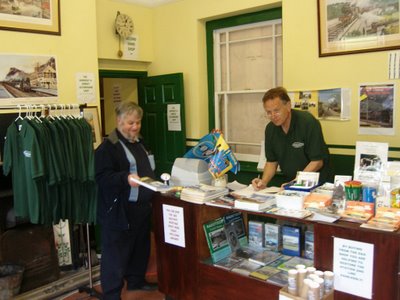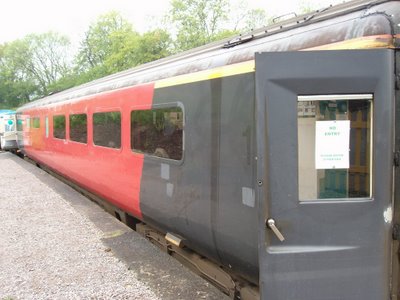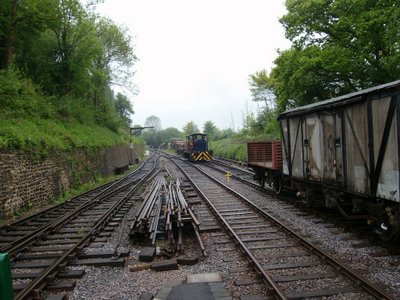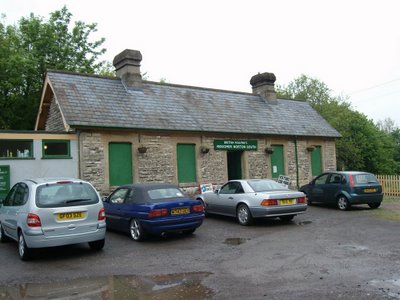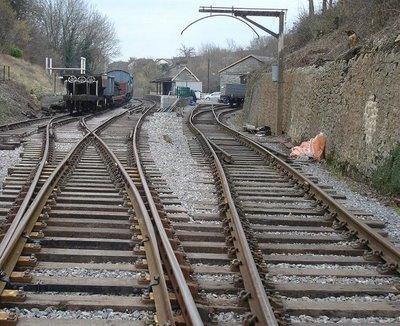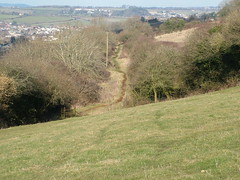The Somerset and Dorset Railway was a unique institution in England - a cross-country main line railway that had the atmosphere of a family-run branch line. Winding its way through the beautiful countryside south of Bath, over spectacular viaducts and through gloomy tunnels, cutting across the coalfields around Radstock and Midsomer Norton, steaming over the fierce gradients to crest the Mendips at Masbury, sleepily coasting through Shepton and Evercreech Junction to make mysterious maneouvres at Templecombe, then down through the glorious Stour Valley and on to Bournemouth it was a line made to burn memories. It gained an iconic status amongst railway enthusiasts and lovers of the British countryside, through the superb photographs of people like Ivo Peters and Derek Cross, and the sheer eccentricities and variety of its operation. In the 1950s the line was incredibly busy, particularly on summer Saturdays with many expresses running from the north and Midlands to the seaside at Bournemouth.
In 1966, with the strange short-sightedness of distant governments - Tory and Labour - who could never have begun to understand its appeal or importance, especially for a future age where oil begins tto run out, it was closed amidst rumours of dodgy accounting, diverted traffic and underhand tactics.
Ten years later, with revival attempts at Radstock being killed stone-dead by the strange short-sightedness of local government, all was quiet on the S&D. The track had been torn up, stations and signalboxes knocked down and even the empty trackbed began to disappear under bushes and trees.
But amazingly Midsomer Norton South station survived through the dark days of the seventies, eighties and nineties. True, the signalbox and greenhouse had vanished, and the bridge over Silver Street removed, and a huge pile of debris blocked the line just south of the station. Rubble had also been used to fill the gap between the platforms, and the interior of the station was gutted, but it was still clearly a station. Even the signal on the up line to Bath remained for many years, though was taken by scrap metal enthusiasts some time in the 1980s, stolen in broad daylight.
Midsomer Norton station was always well-known and loved because of its setting and particularly its gardens. In fact plants from the original gardens reseeded throughout the years of closure and can now be seen in the new beds. Its neat station, signalbox and various buildings blended in very well with the lush countryside of the Mendip foothills, and it was one of the icons of the S&D.
Away from Norton Radstock the phenomena of rail revival was making incredible strides. Closed lines were being taken over by enthusiasts, lovingly restored and quickly establishing themselves as major tourist attractions in many areas. Towns and villages along these lines were seeing huge benefits to their local economies as tourists flocked to travel on the lines, come rain or shine, and spend money in local shops and businesses. Although normally opened using volunteers, many of the busier lines soon needed to employ people, especially in the peak summer months, further invigorating the local economy
Radstock must have been kicking itself as memories of what should have been its major tourist attraction - steam trains between Radstock and Writhington on the famous S&D - began to fade as quickly as the physical remains of the line.
But Midsomer Norton hung on. The crisis came in 1995 after a few years of complete disuse plans were lodged to build houses on the station site. This galvanised a few local people to begin to campaign to save the station for tourist use. Against the odds they succeeded and the S&D was about to get its second wind.
Eleven years on the station site is buzzing, especially on a Sunday when the track gang is busy. The station has been fully restored, the signalbox has been rebuilt up to the top of the windows with the roof to follow very soon, the tracks are back and now head tantalisingly round the corner towards Chilcompton. There are carriages and wagons, a diesel locomotive and a steam Sentinel loco being restored. Inside the station there is a very busy shop selling S&D and other railway items, and in another room there is a popular secondhand shop selling mainly books. On the cattle dock siding there sits a splendid first class buffet coach which will be selling food and drink from May. It’s been a very long haul from the beginnings in 1995 to today, and an awful lot of hard work from a small bunch of volunteers, but we’ve now firmly established ourselves nationally on the heritage railway map.

In July 2005 steam returned to the S&D in the shape of a ‘Jinty’ tank engine, a locomotive familar to anybody who knew the old S&D. The sight of a large engine running down Charlton Road on the back of a flatbed lorry was extraordinary. Although only with us for two weekends, the Jinty brought many new visitors to us (and to the shops in Midsomer Norton!) and our membership increased spectacularly. We featured on television, in the local press and the national railway press. The closure of the S&D, once thought permanent, was at last made temporary! In November a second steam engine, Lord Fisher from Cranmore, stayed with us for almost four months. A real treat for many was the ‘Driver for a Fiver’ experience, where for just five pounds anyone could drive the loco up to the end of the line and back. Santa visited in December, handing out presents to children whilst their mums and dads were busy driving Lord Fisher.
In March this year the fortieth anniversary of the temporary closure of the S&D was marked at Bath Green Park station, superbly restored by Sainsbury’s. One of the famous 7F locos, so emblematic of the S&D, was displayed on a short length of track under the roof of the old station. This brought thousands of visitors to Bath, many also visited us at Midsomer Norton over the long weekend.
What is happening is that events are beginning to take place at various points on the S&D, the whole line is stirring from its long sleep, and many new enthusiasts for the S&D are now emerging from the younger generation. In September we hope to repeat the Combe Down Tunnel walk with the cooperation of Wessex Water. Combe Down Tunnel, just south of Bath, is a mile long and was famous for being the longest tunnel in the UK with no ventilation shafts, a nightmare for steam train crews, but much more comfortable for walkers in the twenty first century!
In Dorset Shillingstone station is now being restored, track has been laid and a 9F locomotive has been brought to the site. And just south of Templecombe the charming Gartell Light railway runs trains on a narrow two foot gauge track partly on the route of the S&D. Far from being dead the S&D is now finding new life and activity bursting out all along the route.
Back at Midsomer Norton we are looking forward to the next few years. We expect to be running regular passenger trains by early 2007 at the latest. Negotiations with the owners of the next two sections of trackbed towards Chilcompton are now well advanced, with much of the track materials for the extension already sourced or on site. The signalbox roof should appear soon and more rolling stock will be coming to the site. The stable block above the station will become the S&D Museum, once funding is in place, and will not only be a showpiece for rare S&D artefacts, but will also contain a research library and photo archive and a meeting space for local groups and societies. The buffet coach will offer a greatly enhanced service, with kids’ birthday parties and dining opportunities on special occasions.
It is Trust policy to employ local businesses wherever possible, so our presence is already beginning to help the local economy. Once visitors flock to travel on the trains we should have even more money to spend locally!
For the next few years we will be concentrating on developing the Midsomer Norton site and building the line southwards to a temporary station at Chilcompton Tunnel. This will give a two mile return trip. We would hope to have a steam engine permanently on site.
The S&D was of course a long main line, and the constitution of the Trust charges us with preserving and restoring the line at all points where it is viable. Although the main thrust at the moment is at Midsomer Norton, we would always be interested in acquiring sections of trackbed along the route, and have a fund for this purpose. We also support any recreational use for any sections of the line, as cycle routes, footpaths and bridleways, particularly where their presence will not prejudice eventual restoration of the railway.
Over the medium term our intention is to rebuild the line back to Radstock, which will require the replacement of two bridges, with a new station in Radstock as close to the Mining Museum as possible, but on the opposite side of the Bath road. Southwards there are no insurmountable obstacles on the route to Shepton, so we would expect to gradually rebuild the line in that direction as well. But this is only the start.
For in the background is the spectre of Peak Oil, and the inevitable decline of the motor car and roads over the next few decades. Rail is already being revived all over the world, with new lines and stations opening even in backwards old Britain! At some time in the future the S&D will be rebuilt, and our hope is that we will be strong and established enough to be the people to do it. That brings a return to Bath into the picture, as well as developments on the line south of Shepton. Many heritage lines are already changing into multi-purpose lines, offering park-and-ride and commuter services. Imagine a commuter and shopping service from Midsomer Norton and Radstock into Bath! Irresistable ....
And who knows, by 2066, the hundredth anniversary of the temporary closure of the S&D, we may well see two woodburning steam locomotives leaving a restored Bath Green Park station with a packed trainload of passengers taking a trip to a sub-tropical Bournemouth through some of England’s finest scenery. On its way it’ll cross magnificently restored stations, pass through long tunnels and over magnificent viaducts and turn heads through the numerous villages and towns that now have a fully restored passenger and freight service after years of decline, closure and gradual rebuilding of the route. The very idea that a railway linking Britain’s only World Heritage city to its premier seaside resort was once closed would seem incredible to our descendants.
So how can you be part of the great S&D revival? Membership of the Trust is not expensive, and for your ten pounds or so a year you get 3 or 4 copies of our excellent award-winning magazine, a 10% discount in the shop and the chance to work on the line. Yes, you pay us to work! One of the nice things about the new S&D is that it has the same range of characters that the old S&D had - in fact, several of our working members are ex-S&D railwaymen, and many other volunteers knew the line well. Jobs include working on the engines and rolling stock, tracklaying, fencing and gardening, helping in the shop or the office. It doesn’t matter if you’re young or old, male or female, as strong as an ox or as feeble as Mr Bean, we’ll keep you fully occupied and you’ll make loads of new friends and learn a few new skills along the way. And you’ll get the satisfaction that you’ll be part of the most exciting rail restoration project in Europe, the return of the S&D.






